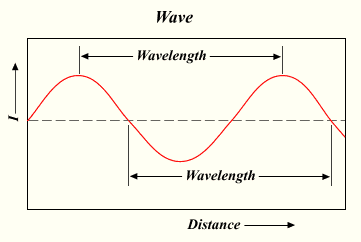Sine wave
A sine wave is a curve, a continuous function with this shape:

This is a picture of a sine wave.
All waves can be made by adding up sine waves. The sine wave has a pattern that repeats. The length of this repeating piece of the sine wave is called the wavelength. The wavelength can be found by measuring the length or distance between one peak of a sine wave and the next peak. The wavelength can be found in many other ways too.
Waves made of Sine Waves
changeWaves are found everywhere in the natural world. Examples of waves:
- sound
- light
- water waves
- earthquake waves
All of these waves are the sum total of many signals.
Properties of Sine Waves
changeSine waves have a "length" called a wavelength. There are other properties of waves and sine waves, such as their frequency, amplitude, phase, and speed.
Sine waves repeat over time, so this makes them periodic. The time it takes for a part of the sine wave (one cycle) to travel before it repeats itself is called the period, represented by the letter T. The frequency of a sine wave is the number of oscillations it makes in one second. This is measured in Hertz, which have units of s-1. The frequency can be found by dividing 1/T (this is also called taking the reciprocal).
The amplitude of the wave corresponds to how powerful the signal is. For example, a higher amplitude in a sound wave means it is louder.